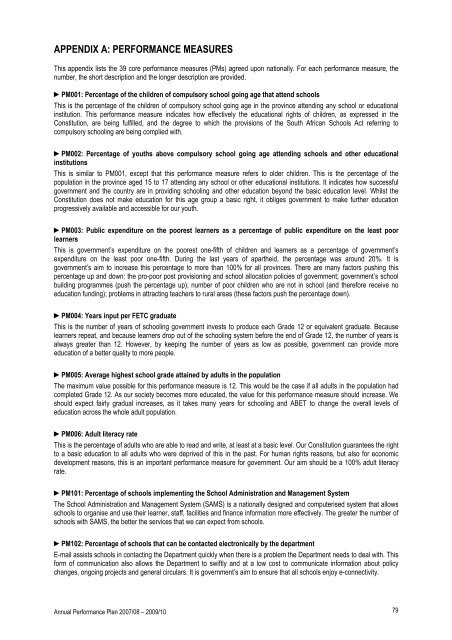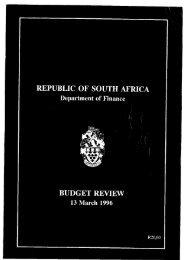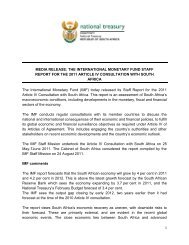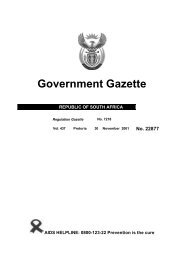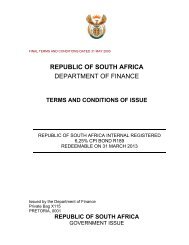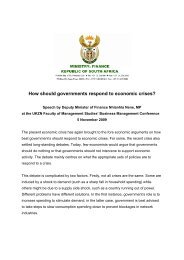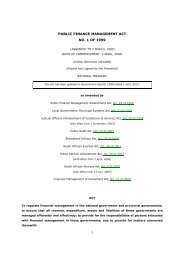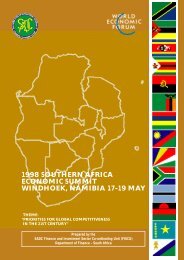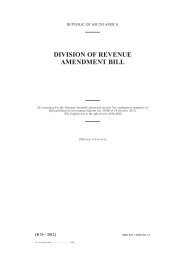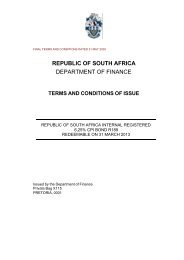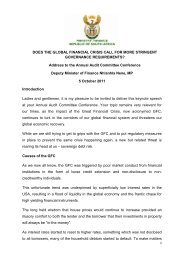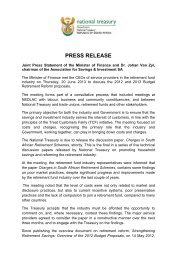Annual Performance Plan Jaarlikse ... - National Treasury
Annual Performance Plan Jaarlikse ... - National Treasury
Annual Performance Plan Jaarlikse ... - National Treasury
You also want an ePaper? Increase the reach of your titles
YUMPU automatically turns print PDFs into web optimized ePapers that Google loves.
APPENDIX A: PERFORMANCE MEASURES<br />
This appendix lists the 39 core performance measures (PMs) agreed upon nationally. For each performance measure, the<br />
number, the short description and the longer description are provided.<br />
►PM001: Percentage of the children of compulsory school going age that attend schools<br />
This is the percentage of the children of compulsory school going age in the province attending any school or educational<br />
institution. This performance measure indicates how effectively the educational rights of children, as expressed in the<br />
Constitution, are being fulfilled, and the degree to which the provisions of the South African Schools Act referring to<br />
compulsory schooling are being complied with.<br />
►PM002: Percentage of youths above compulsory school going age attending schools and other educational<br />
institutions<br />
This is similar to PM001, except that this performance measure refers to older children. This is the percentage of the<br />
population in the province aged 15 to 17 attending any school or other educational institutions. It indicates how successful<br />
government and the country are in providing schooling and other education beyond the basic education level. Whilst the<br />
Constitution does not make education for this age group a basic right, it obliges government to make further education<br />
progressively available and accessible for our youth.<br />
►PM003: Public expenditure on the poorest learners as a percentage of public expenditure on the least poor<br />
learners<br />
This is government’s expenditure on the poorest one-fifth of children and learners as a percentage of government’s<br />
expenditure on the least poor one-fifth. During the last years of apartheid, the percentage was around 20%. It is<br />
government’s aim to increase this percentage to more than 100% for all provinces. There are many factors pushing this<br />
percentage up and down: the pro-poor post provisioning and school allocation policies of government; government’s school<br />
building programmes (push the percentage up); number of poor children who are not in school (and therefore receive no<br />
education funding); problems in attracting teachers to rural areas (these factors push the percentage down).<br />
►PM004: Years input per FETC graduate<br />
This is the number of years of schooling government invests to produce each Grade 12 or equivalent graduate. Because<br />
learners repeat, and because learners drop out of the schooling system before the end of Grade 12, the number of years is<br />
always greater than 12. However, by keeping the number of years as low as possible, government can provide more<br />
education of a better quality to more people.<br />
►PM005: Average highest school grade attained by adults in the population<br />
The maximum value possible for this performance measure is 12. This would be the case if all adults in the population had<br />
completed Grade 12. As our society becomes more educated, the value for this performance measure should increase. We<br />
should expect fairly gradual increases, as it takes many years for schooling and ABET to change the overall levels of<br />
education across the whole adult population.<br />
►PM006: Adult literacy rate<br />
This is the percentage of adults who are able to read and write, at least at a basic level. Our Constitution guarantees the right<br />
to a basic education to all adults who were deprived of this in the past. For human rights reasons, but also for economic<br />
development reasons, this is an important performance measure for government. Our aim should be a 100% adult literacy<br />
rate.<br />
►PM101: Percentage of schools implementing the School Administration and Management System<br />
The School Administration and Management System (SAMS) is a nationally designed and computerised system that allows<br />
schools to organise and use their learner, staff, facilities and finance information more effectively. The greater the number of<br />
schools with SAMS, the better the services that we can expect from schools.<br />
►PM102: Percentage of schools that can be contacted electronically by the department<br />
E-mail assists schools in contacting the Department quickly when there is a problem the Department needs to deal with. This<br />
form of communication also allows the Department to swiftly and at a low cost to communicate information about policy<br />
changes, ongoing projects and general circulars. It is government’s aim to ensure that all schools enjoy e-connectivity.<br />
<strong>Annual</strong> <strong>Performance</strong> <strong>Plan</strong> 2007/08 – 2009/10<br />
79


